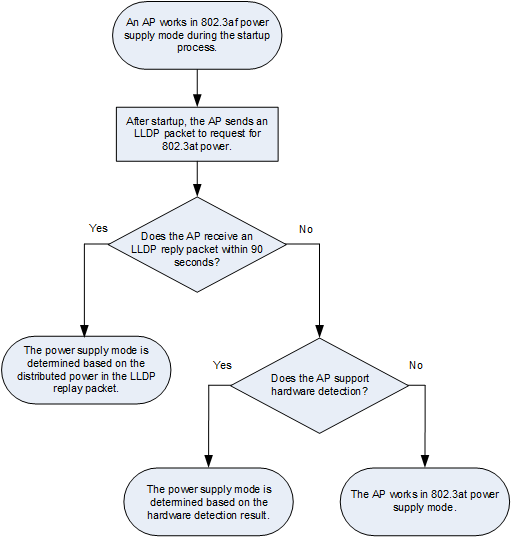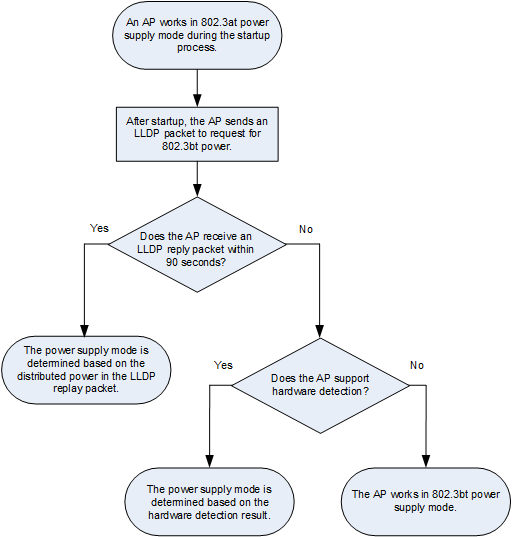Understanding PoE
Components in a PoE System
- Power-sourcing equipment (PSE): The PSE provides power for powered devices (PDs) on the Ethernet, and supports detection, analysis, and intelligent power management.
- PD: PDs are provided with power, such as wireless APs, portable device chargers, POS machines, and cameras. According to whether a PD conforms to an IEEE standard, PDs are classified into standard and non-standard PDs.
- PoE power supply: The PoE power supply provides power for the PoE system. The number of PDs connected to the PSE is limited by power of the PoE power supply. According to whether a PoE power supply is swappable, PoE power supplies are classified into built-in and external power supplies.
PoE Power Supply Standards
PoE power supply standards include IEEE 802.3bt, IEEE 802.3at, and IEEE 802.3af. PoE technical specifications vary depending on the PoE power supply standard. For details, see Table 1.
- 802.3bt AP: is also called UPoE AP, and supports IEEE 802.3bt and IEEE 802.3at. Functions supported by APs vary depending on the PoE power supply standard. For details, see the 802.3bt AP sheet in AP Functions Supported in Different Power Supply Standards.
- 802.3at AP: supports IEEE 802.3at and IEEE 802.3af. Functions supported by APs vary depending on the PoE power supply standard. For details, see the 802.3at AP sheet in AP Functions Supported in Different Power Supply Standards.
- 802.3af AP: supports only IEEE 802.3af. In IEEE 802.3af, functions of an 802.3af AP are not restricted.
The AP5510-W-GP supports DC power supply only through a matching power adapter.
APs in the preceding example are 802.3bt APs and 802.3at AP, while others are 802.3af APs.
Working Process of PoE Power Supply
802.3bt AP
Figure 1 shows the PoE working process of an 802.3bt AP.
The 802.3bt APs that support hardware detection include the AP7060DN, AP7052DN, AP7152DN, AP6052DN, AP7052DE, AP8082DN, and AP8182DN.
802.3bt APs that do not support hardware detection include the AP7050DN-E.
802.3at AP
Figure 2 shows the PoE working process of an 802.3at AP.
802.3at APs that support hardware detection include the AP4050DE-M, AP4050DE-M-S, AP4050DE-B-S, AP3050DE, AP2051DN-L-S, AirEngine 5760-10, AP4050DN-HD, R250D-E, AP2050DN, AP2050DN-S, AP2050DN-E, AP4051DN, AP4151DN, and AP4051DN-S.
802.3at APs that do not support hardware detection include the AP8030DN, AP8130DN, AP7030DE, AP9330DN, AP9131DN, AP9132DN, AP4030TN, AP4050DN-E, AP6050DN, AP6150DN, AP7050DE, AP4051TN, AP8050TN-HD, AP8050DN, AP8150DN, and AP8050DN-S.
802.3af AP
APs always work in 802.3af power supply mode after being started.
PoE Power Management Mode
When PDs connected to the PSE increase, the PoE power supply cannot provide power for all PDs. Therefore, the PSE should manage the power supply. Power management is classified into two modes: automatic and manual.
Automatic mode: The PSE automatically powers on or powers off PDs based on power priorities. You can configure a power priority of each port as Critical, High, or Low based on the importance of the PD connected to each port. When providing power nearly at full capacity, the PSE provides power first for the PD connected to the port of Critical priority and then provides power for the PD connected to the port of High priority. If multiple PoE ports have the same priority, the system first supply power to the PDs connected to the ports with smaller port numbers.
Manual mode: You can manually power on or power off ports. In manual mode, the PSE provides power for a port without considering the priority. Powering on or powering off a single port does not affect the power supply status. When providing power nearly at full capacity, the PSE cannot continue to power on a new PD.
Power Supply Mode of PSEs
As defined in IEEE standard, PSEs provide power for PDs and are classified into MidSpan (the PoE module is installed out of the device) and Endpoint (the PoE module is integrated to device) PSEs. Huawei's PoE modules are Endpoint PSEs. The Endpoint PSE is compatible with 2.5GE Base-T, 1000Base-T, 100Base-TX, and 10Base-T ports. The Endpoint PSE is more widely used than the Midspan PSE.
Alternative A mode: Power is transmitted over pairs of lines that transmit data.
The PSE provides power for the PD over copper line pairs connected to pins 1 and 2 and pins 3 and 6. Pins 1 and 2 use the positive voltage and pins 3 and 6 use the negative voltage.
10Base-T and 100Base-TX ports use copper line pairs connected to pins 1 and 2 and pins 3 and 6 to transmit data, and 1000Base-T ports use four line pairs to transmit data. DC power and data frequency are independent. Therefore, the power and data can be transmitted in one pair of lines.
Alternative B mode: Power is transmitted over idle pairs of lines.
The PSE provides power for the PD over copper line pairs connected to pins 4 and 5 and pins 7 and 8. Pins 4 and 5 use the positive voltage and pins 7 and 8 use the negative voltage.
Generally, a standard PD supports the two modes, whereas the PSE only needs to support one mode. Huawei PSE supports only Alternative A.
PoE Technical Specifications
PoE technical specifications vary depending on PoE technologies. You can select the required PoE technology to power on PDs according to PD requirements.
Power supply technology |
PoE |
PoE+ |
PoE++ |
|---|---|---|---|
Power supply distance |
100 m |
100 m |
100 m |
Power class |
0-3 |
0-4 |
0-8 |
Maximum current |
350 mA |
600 mA |
1730 mA |
PSE output voltage |
44 V DC-57 V DC |
50 V DC-57 V DC |
50 V DC-57 V DC |
PSE output power |
≤ 15400 mW |
≤ 30000 mW |
≤ 90000 mW |
PD input voltage |
36 V DC-57 V DC |
42.5 V DC-57 V DC |
42.5 V DC-57 V DC |
Maximum PD power |
12950 mW |
25500 mW |
81600 mW |
Cable requirements |
Unstructured |
CAT-5e or better |
CAT-5e or better |
Power supply cable pairs |
2 |
2 |
4 |
- PoE technology complies with IEEE 802.3af.
- PoE+ technology complies with IEEE 802.3at.
- PoE++ technology complies with IEEE 802.3bt.

